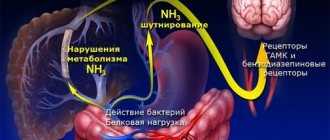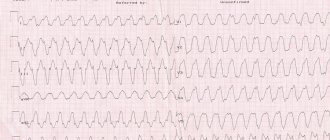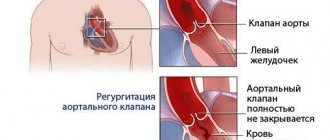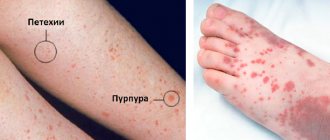Liver failure is a complex of complex symptoms that is characterized by a violation of the vital functions of the liver, caused by acute or chronic damage to the organ tissue.
Any abnormal liver function requires immediate medical intervention. There are acute and chronic liver failure. Chronic liver failure develops over several months or years, but acute liver failure can develop within a few hours.
What functions does the liver perform?
The content of the article
The liver is a large organ located in the abdominal cavity. This important organ performs various functions and takes a significant part in regulating the homeostasis of the body.
The most important functions of the liver:
- metabolic function - processing of carbohydrates, proteins, fats;
- storage - including iron and vitamins;
- detoxification - the liver is involved in the removal of harmful substances in food, as well as medications;
- production of bile, which is especially important when digesting fats;
- Immune function - Some liver cells play an important role in immune responses.
Sources
- Acute Liver Failure. Mescape. Updated: Jun 13 2021 — https://emedicine.medscape.com/article/177354-overview
- Pediatric Liver Transplantation. Medscape. Updated: March 17 2019 —https://emedicine.medscape.com/article/1012910-overview
- Liver Transplants. Medscape. Updated: December 31, 2021 — https://emedicine.medscape.com/article/776313-overview
- Intravenous N-acetylcysteine improves transplant-free survival in early stage non-acetaminophen acute liver failure. Pubmed - https://www.ncbi.nlm.nih.gov/pubmed/19524577
- Fulminant Hepatitis. Family Practice —https://www.fpnotebook.com/GI/Lvr/FlmntHpts.htm#fpnContent-panel-id_2
- Acute Liver Failure in Children. Medscape - https://www.medscape.com/viewarticle/584466_1
- The contributions of hepatitis B virus and hepatitis C virus infections to cirrhosis and primary liver cancer worldwide. PubMed —https://www.ncbi.nlm.nih.gov/pubmed/16879891
- Cirrhosis. Medscape. Updated: 30 July 2017 —https://emedicine.medscape.com/article/185856-overview
- MELD Score for End-Stage Liver Disease (NOT appropriate for patients under the age of 12). Medscape —https://reference.medscape.com/calculator/meld-score-end-stage-liver-disease
- Acute liver failure. PostgradMed —https://www.ncbi.nlm.nih.gov/pmc/articles/PMC1743234/pdf/v081p00148.pdf
- Modern prognostic models of survival of patients with terminal stage diseases. Journal of Clinical and Experimental Surgery - https://www.cesurg.ru/ru/jarticlescesurg/60.html?SSr=40013379b601ffffffff27c_07df070a01282f-690 12.Overview of the Indications and Contraindications for Liver Transplantation. PMC _ https://www.ncbi.nlm.nih.gov/pmc/articles/PMC3996378/
- Liver transplantation for acute hepatic failure. PMC—https://www.ncbi.nlm.nih.gov/pmc/articles/PMC2131363/
- Indications and Contraindications for Liver Transplantation. International Journal of Gepatology - https://www.hindawi.com/journals/ijh/2011/121862/
- Liver transplantation for chronic liver disease: advances and controversies in an era of organ shortages. Postgraduate Medical Journal - https://pmj.bmj.com/content/78/917/135
- Extracorporeal liver support. Organogenesis —https://www.ncbi.nlm.nih.gov/pmc/articles/PMC3082035/
- Lifestyle Changes to Manage Cirrhosis. Winchester Hospital —https://www.winchesterhospital.org/health-library/article?id=19276
- What Are the Treatments for Cirrhosis?. WebMd —https://www.webmd.com/digestive-disorders/tc/cirrhosis-home-treatment#2
- Cirrhosis and Chronic Liver Failure: Part II. Complications and Treatment. American Family Physician - https://www.aafp.org/afp/2006/0901/p767.html https://www.aafp.org/afp/2006/0901/p767.html
- The use of extracorporeal methods for the treatment of liver failure. Kutepov Dmitry Evgenievich - https://cyberleninka.ru/article/n/ispolzovanie-ekstrakorporalnyh-metodov-lecheniya-pechyonochnoy-nedostatochnosti
What are the causes of liver failure?
There are acute and chronic liver failure.
Chronic liver failure is most often caused by cirrhosis and infection with hepatitis viruses (hepatitis B and C), which ultimately also leads to cirrhosis.
Cirrhosis
Cirrhosis is a disease in which fibrous reconstruction of the liver occurs, as a result of which its function is impaired. The most common cause of liver cirrhosis is alcohol abuse. Other, rarer causes include:
- autoimmune hepatitis;
- primary biliary cirrhosis;
- metabolic diseases;
- chronic use of certain medications.
Infection with hepatotropic viruses is a chronic infection. The liver is usually affected by viruses type B and C. In addition to cirrhosis, chronic hepatitis may predispose to the formation of hepatocellular carcinoma.
Acute liver failure is a sudden and rapid deterioration of liver function that after a few weeks leads to encephalopathy, bleeding disorders and, if untreated, death.
Causes of acute liver failure:
- acute viral hepatitis, mainly types A and B;
- some medications - most often paracetamol, halothane, sulfonamides, statins;
- poisoning;
- severe systemic diseases - shock, sepsis, portal vein thrombosis, etc.
3. Treatment of the disease
If liver failure caused by acetaminophen overdose is diagnosed early enough, the disease can sometimes be cured completely and all negative effects eliminated. Similarly in the case of a virus, if liver failure occurs due to a virus, supportive care in a hospital will help avoid serious consequences until the virus passes. In these cases, the liver can recover on its own.
For liver failure, when severe liver damage has already occurred, the first goal of treatment may be to preserve the part of the liver that is still able to function. If this is not possible, then a liver transplant is not required. But even in cases where a liver transplant is necessary, this operation is usually successful.
About our clinic Chistye Prudy metro station Medintercom page!
Symptoms of liver failure
Symptoms of liver cirrhosis develop slowly and are not noticed by the patient for a long time. At first, patients usually complain of weakness, itchy skin and jaundice. As the disease progresses, muscle atrophy and ascites appear - the patient's abdominal circumference increases, with rather thin limbs.
Other symptoms of liver cirrhosis:
- low-grade fever;
- lack of appetite, weight loss;
- vascular bundles on the skin;
- palmar erythema (redness);
- excessive hair growth in women;
- dilated venous vessels of the abdominal wall (“head of the jellyfish”);
- symptoms of hemorrhagic diathesis due to a deficiency of coagulation factors;
- ascites and pleural fluid - caused by albumin deficiency and leakage of fluid from blood vessels.
Low-grade fever
Lack of appetite
Sexual dysfunction also appears. As a result of disturbances in the metabolism of sex hormones, men experience symptoms of feminization - hair loss on the chest and armpits and gynecomastia, as well as hypogonadism - loss of libido. Women are diagnosed with menstrual irregularities.
2. Symptoms of the disease
The initial symptoms of liver failure are often similar to those of other diseases, including the most common ones. Because of this, liver failure can be difficult to diagnose early in the disease. The first signs of liver failure may be:
- Nausea;
- Loss of appetite;
- Fatigue;
- Diarrhea.
As liver failure progresses, symptoms become more severe and require immediate medical attention:
- Jaundice;
- Minor bleeding;
- Constipation;
- Mental disorientation and confusion (hepatic encephalopathy);
- Drowsiness;
- Coma.
Visit our Hepatology page
Complications of liver failure and cirrhosis
Cirrhosis leads to a serious complication - portal hypertension. This is an increase in blood pressure in the portal vein system, which, when transferred to subsequent vessels, causes collateral circulation in the form of, among other things, esophageal varices. This is a serious complication that can lead to massive gastrointestinal bleeding. This may be the first sign of cirrhosis.
Other complications of liver cirrhosis:
- Ascites is the accumulation of fluid in the abdominal cavity caused by a deficiency of albumin in the blood plasma;
- Spontaneous bacterial peritonitis caused by the penetration of bacteria from the intestinal lumen into the peritoneum. Pathogens cause infection of ascites fluid. In this case, the symptoms are rarely typical for peritonitis; fever, abdominal pain, and encephalopathy are usually observed;
- Hepatorenal syndrome, that is, deterioration of renal function in liver cirrhosis. The occurrence of this syndrome is an indicator of poor prognosis, as renal function may rapidly deteriorate, leading to end-stage renal disease with the need for dialysis in the short term;
- Hypersplenism is excessive splenic function causing pancytopenia in some patients;
- Acute liver failure. This is a sudden and rapid impairment of liver function, which mainly manifests itself in the rapid development of encephalopathy and the appearance of plasma coagulation disorders.
- Hepatic encephalopathy is a collection of neurological and psychological symptoms resulting from impaired elimination of toxins from the body. They enter the central nervous system, causing disturbances in consciousness, dementia, behavioral disorders and brain damage.
Symptoms of acute liver failure are plasma ecchymotic coagulation disorders, bleeding, and in rare cases, overt bleeding, usually from the gastrointestinal tract.
Publications in the media
Liver failure (LF) is a failure of liver function of varying severity. Hepatic encephalopathy is a neuropsychiatric syndrome caused by impaired liver function and portal-systemic shunting of venous blood.
Etiology • Diseases accompanied by damage to the liver parenchyma •• Acute and chronic hepatitis •• Cirrhosis •• Liver tumors •• Parasitic diseases •• Fatty liver of pregnant women •• Reye's syndrome • Cholestasis •• Tumors of the biliary tract •• Gallstone disease •• Primary biliary cirrhosis • Endogenous intoxications •• Extensive injuries •• Extensive burns •• Sepsis • Taking drugs •• Tranquilizers •• Sedatives •• Analgesics •• Diuretics •• Hepatotoxic drugs (for example, paracetamol, fluorotan).
Risk factors for the development of PN and hepatic encephalopathy in a patient with liver pathology • Excessive protein intake from food • Bleeding from the gastrointestinal tract • Water-electrolyte imbalance as a result of forced diuresis, diarrhea, vomiting, paracentesis • Surgical interventions • Constipation • Taking sedatives • Infections • Alcohol abuse.
Pathogenesis • PN occurs either as a result of necrosis of hepatocytes (reduction in the number of functioning cells), or due to porto-caval shunting of the blood, or a combination of both processes • Jaundice can be caused by insufficiency of conjugative (with necrosis of hepatocytes) or excretory (with cholestasis) functions liver, or a combination of them • Violation of the synthetic function of the liver leads to the development of hypoalbuminemia (promotes the occurrence of edema and ascites), a lack of blood coagulation factors (hemorrhagic syndrome) • A decrease in the detoxification function of the liver leads to the development of intoxication and hepatic encephalopathy •• A decrease in the synthesis of urea from ammonia begins with necrosis of more than 80% of hepatocytes; in liver cirrhosis, the concentration of ammonia also increases due to blood shunting through portocaval anastomoses •• In the pathogenesis of hepatic encephalopathy, the main importance is given to an excess of endogenous toxic products against the background of loss of detoxification function of the liver and blood shunting and changes in amino acid metabolism, which leads to disturbances in the neurotransmitter systems of the brain brain • Impaired metabolism of steroid hormones leads to increased concentrations of estrogen in the blood serum (endocrine disorders, spider veins) and hyperaldosteronism (ascites) •
Dilatation of arterial vessels (the reasons are not precisely established) leads to arterial hypotension, and then to activation of the sympathetic and renin-angiotensin systems, sodium and water retention and the development of ascites.
CLINICAL MANIFESTATIONS • The severity of the disorders is variable. Minor disorders of liver function, and disorders that develop gradually, are often asymptomatic • Weakness, fatigue • Jaundice (with a predominance of hepatocyte necrosis, it becomes orange, with a predominance of cholestasis - green) • Decreased blood pressure, tachycardia • Fever • Urinary, respiratory tract infections, sepsis ( staphylococcus, gram-negative microflora) • Hepatic breath • Hemorrhagic cider (nasal, gingival, uterine, renal bleeding, vomiting of coffee grounds or streaked with blood, tarry stools, hemorrhages on the skin [petechiae, ecchymoses] and mucous membranes) • Spider veins • Chronic PN •• Cyanosis, fingers in the form of “drum sticks” •• Endocrine changes: testicular atrophy, infertility, decreased libido and potency, menstrual irregularities, gynecomastia, hair loss in areas of secondary hair growth.
• Hepatic encephalopathy •• Acute hepatic encephalopathy ••• Develops with fulminant PN (acute viral and drug hepatitis, mushroom poisoning, ischemia, fatty liver of pregnant women, Reye's syndrome, first manifestation of Wilson's disease, autoimmune hepatitis) ••• May occur spontaneously, or in the presence of risk factors, or with the development of necrosis in a patient with chronic liver pathology with developed shunts • Chronic hepatic encephalopathy is caused by significant portosystemic shunting. After several years of chronic hepatic encephalopathy, the patient may develop paraplegia, parkinsonism, dementia and other organic lesions of the central nervous system •• There are 4 stages of hepatic encephalopathy ••• I - euphoria or depression, delayed mental reactions, sleep inversion, initial speech and writing disorders • •• II (somnolence) - confusion, inappropriate behavior, flapping tremor, delirium with convulsions and motor agitation periodically occurs, ataxia, dysarthria, hyperreflexia ••• III (stupor) - severe disturbances of consciousness, sometimes short-term agitation, dysarthria, decreased pupillary reflexes, hyperreflexia, pathological reflexes, skeletal muscle rigidity, urinary incontinence ••• IV (coma) - consciousness is absent, the reaction to painful stimuli disappears, reflexes fade.
Features of fulminant PN • Develops within 8 weeks from the moment the first signs of the disease or jaundice appear •• Hyperacute - development in the first 7 days of the disease •• Acute - development from the 8th to the 28th day of the disease •• Subacute - development on 5– 12th week of illness •• Nausea and vomiting appear early, then jaundice and hepatic encephalopathy develop •• With hyperacute and subacute FPN, encephalopathy can develop before the appearance of jaundice •• The liver usually decreases in size, becomes soft, flabby, painful on palpation (signs massive necrosis) •• In patients with a more gradual development of PN, cerebral edema occurs less frequently, but ascites and renal failure occur.
Laboratory tests • Blood test: with chronic liver disease, the content of platelets, leukocytes, erythrocytes decreases (hypersplenism), with fulminant PN, leukocytosis develops with a neutrophilic shift to the left, ESR increases • Concentration of procoagulants, albumin, cholesterol, lipoproteins (and other compounds synthesized by the liver) in the blood serum is reduced •• With fulminant PN, it is important to determine the concentration of procoagulants, since they have a short half-life and their concentration decreases faster than other proteins • The concentration of bilirubin in the blood serum is increased, with liver necrosis the concentration of indirect bilirubin increases • The activity of serum transaminases during necrosis sharply increases, then decreases • Ammonia concentration increases with necrosis of 80% of hepatocytes and with chronic hepatic encephalopathy • Hypoglycemia • Blood gas composition • Blood test for markers of viral hepatitis • Determination of the concentration of alcohol, drugs and drugs in the blood.
Instrumental studies • EEG reveals nonspecific changes that help in the diagnosis and assessment of the results of treatment of hepatic encephalopathy, incl. in patients who are clearly conscious • Daily monitoring of liver size using a portable ultrasound device for fulminant PN • Liver biopsy for fulminant PN is important for deciding on liver transplantation: necrosis of more than 50% of liver tissue is considered an indication for transplantation.
Differential diagnosis • Alcohol withdrawal syndrome • Intoxication of drugs with sedative effect • Meningitis • Metabolic encephalopathy associated with anoxia, hypoglycemia, hypokalemia, hypo- or hypercalcemia, uremia.
TREATMENT Management tactics • It is necessary to exclude risk factors for the development of PN and hepatic encephalopathy • Avoid alcohol intake • Limit the amount of drugs used.
Acute hepatic encephalopathy • Diet with protein restriction to 20 g/day, preferably vegetable proteins, calorie content 2000 kcal/day • Lactulose (in the form of syrup 10–30 ml 3 times/day or lactiol (30 g/day) suppress the growth of ammoniogenic microflora • • Neomycin orally 1 g 4 times a day for 7 days or metronidazole 200 mg 4 times a day for 5-7 days • Correction of water or electrolyte balance • Prescription of sedatives should be avoided; for convulsive syndrome, diazepam is prescribed . encephalopathy • Diet with protein restriction to 40–60 g/day (preference is given to vegetable proteins) • It is necessary to ensure bowel cleansing at least 2 times a day • Lactulose • If the condition worsens, switch to treatment used for acute hepatic encephalopathy
Fulminant PN • The patient is isolated • The stage of coma is assessed every hour • Monitoring blood pressure, pulse, body temperature •• Control and correction of water and electrolyte balance • Urinary and central venous or arterial catheters are installed • A nasogastric tube is installed • H2 blockers are prescribed to prevent bleeding from the gastrointestinal tract -histamine receptors or omeprazole • Inhalation of oxygen through a mask, in case of coma - tracheal intubation, with paCO2 more than 6.5 kPa and paO2 less than 10 kPa, mechanical ventilation is performed • Correction of hypoglycemia • Relief of arterial hypotension with infusion of albumin, saline solutions, if there is no effect - dopamine or a combination of dopamine with norepinephrine or epinephrine • When the concentration of creatinine in the blood serum is more than 400 µmol/l (4.5 mg%) hemodialysis or hemofiltration is performed • Relief of hemorrhagic syndrome: menadione sodium bisulfite, fresh frozen plasma, platelet mass • Treatment of acute hepatic encephalopathy, but neomycin is not prescribed (nephrotoxic) • Relief of cerebral edema (see. Cerebral edema) • Liver transplantation is indicated for stage III–IV hepatic encephalopathy (increases survival from 20 to 60–80%).
Complications • Cerebral edema • Renal failure (hepatorenal syndrome) • Hemorrhagic syndrome due to depletion of coagulation factors • Infectious complications • Hypoglycemia • Hypokalemia • Acute pancreatitis • Pulmonary complications (aspiration of blood, gastric contents, atelectasis, etc.).
Course and prognosis • Mortality: •• for fulminant PN and hepatic encephalopathy of I-II degree - 20%, hepatic encephalopathy of III-IV degree - 65% •• for acute PN against the background of cirrhosis of the liver - 80% •• for chronic PN - 100 % • The prognosis depends on the severity of liver failure, in patients with acute hepatitis (especially hepatitis D and drug poisoning) the prognosis is worse; in liver cirrhosis, the prognosis worsens in the presence of jaundice, ascites, hypoalbuminemia • Early diagnosis and treatment improves the prognosis • Adverse prognostic signs in fulminant PN - age less than 10 and over 40 years, presence of concomitant diseases, hypoglycemia, duration of jaundice before the development of hepatic encephalopathy more than 7 days, bilirubin concentration in the blood serum more than 300 µmol/l, PT more than 50 s.
Synonyms • Hepatodepression • Portosystemic encephalopathy • Hepatocellular failure Abbreviations. PN - liver failure
ICD-10 • K70.4 Alcoholic liver failure • K71.1 Toxic liver damage with hepatic necrosis • K72 Liver failure, not elsewhere classified
Diagnosis of liver failure
When diagnosing liver failure, the patient's medical history is key. The facts of alcohol abuse and the presence of situations that increase the risk of hepatotropic viral infection are mainly important. Signs of organ failure are identified, for example, the degree of blood clotting disorder is assessed.
During a physical examination, the gastroenterologist notes an enlarged liver - the organ is relatively noticeable when palpating the abdominal wall.
A useful tool in diagnosing liver failure is abdominal ultrasound. The examination helps to accurately assess the size of the liver, its structure, as well as the width of the portal vein (important in the case of portal hypertension) and possible complications, for example, the presence of fluid in the abdominal cavity.
Abdominal ultrasound
Additional tests are laboratory tests, mainly the determination of transaminases and bilirubin, which allow indirect assessment of liver function. These tests should be performed periodically, and the frequency of tests depends on the rate at which symptoms worsen.
Prognosis for acute liver failure
Acute liver failure before the use of modern therapy and liver transplantation led to death in 80% of patients. Currently, this figure has been reduced to 40%. The cause of the disease and the presence of complications are the main factors determining the prognosis.
Patients with acetaminophen-induced liver failure have a better prognosis than those in whom the cause of the disease is unknown. The presence of cerebral edema, renal failure, coagulopathy, or infectious complications worsens the prognosis. Severe hepatic encephalopathy grade 3-4 is also associated with a greater risk of death.
Treatment of chronic liver failure
Drug therapy
| Ascites, edema | Salt-free diet, diuretics (spironolactone, furosemide) |
| Hepatic encephalopathy | Lactulose for detoxification, extracorporeal methods - MARS or Prometheus systems (FPSA), mannitol or barbiturates for cerebral edema |
| Infectious complications | Broad-spectrum antibiotics (cephalosporins) |
| Portal hypertension | Propranolol (prevention of bleeding from the veins of the esophagus) |
| Blood clotting disorder | Vitamin K, platelet transfusion, fresh frozen plasma, blood clotting factor preparations |
Drug therapy options are limited. Early diagnosis and prevention of complications are of primary importance. In case of alcoholic hepatitis, the use of ethyl alcohol, even in minimal doses, is strictly prohibited.
The only treatment method that can save the life of a patient with severe chronic liver failure is liver transplantation.
Prevention
Prevention of acute liver failure involves the prevention of infectious diseases and toxic damage to the organ. For this purpose, it is important to maintain personal hygiene and sexual hygiene, which excludes infection with viral hepatitis, adherence to safety measures when working with toxic substances, strict adherence to drug doses and refusal to take chemicals unless absolutely necessary. Prevention of chronic liver failure involves treatment of liver diseases, preventive courses of hepatorotectors, constant adherence to a diet, and sanatorium-resort treatment. alcoholism plays an important role .










